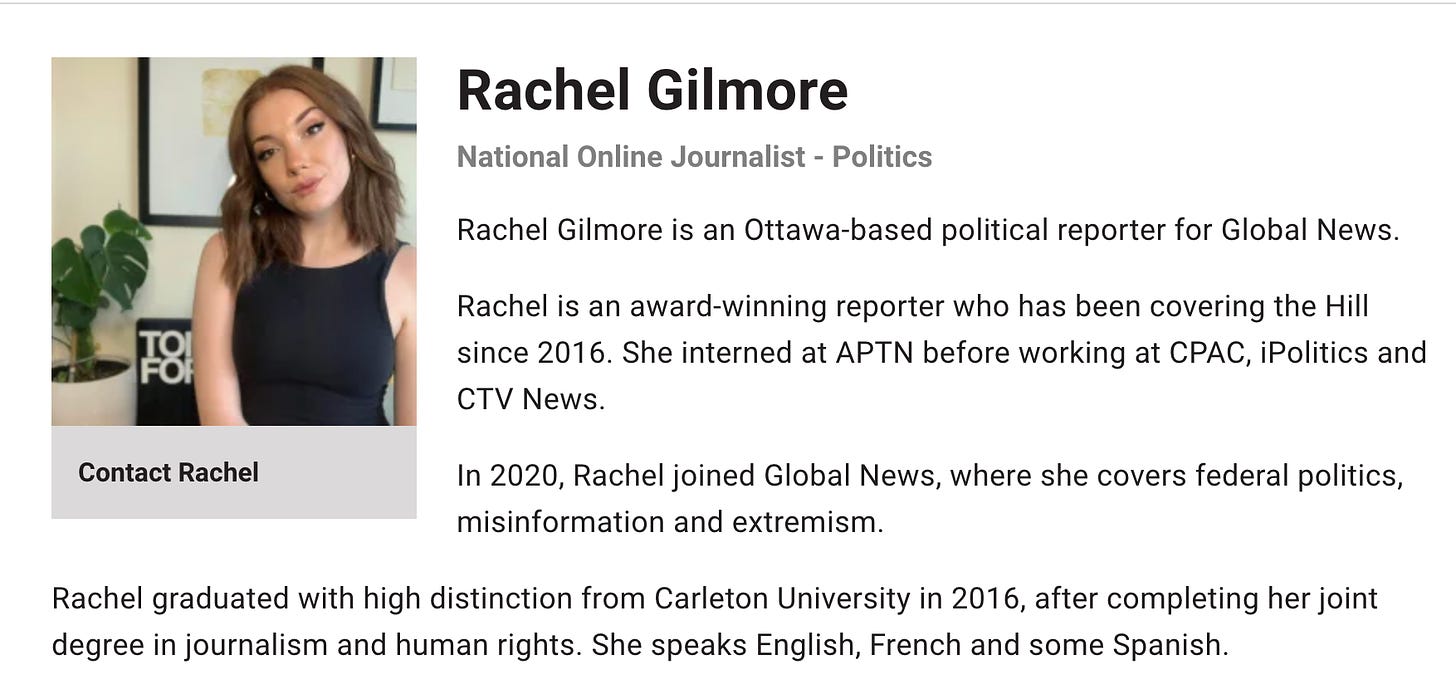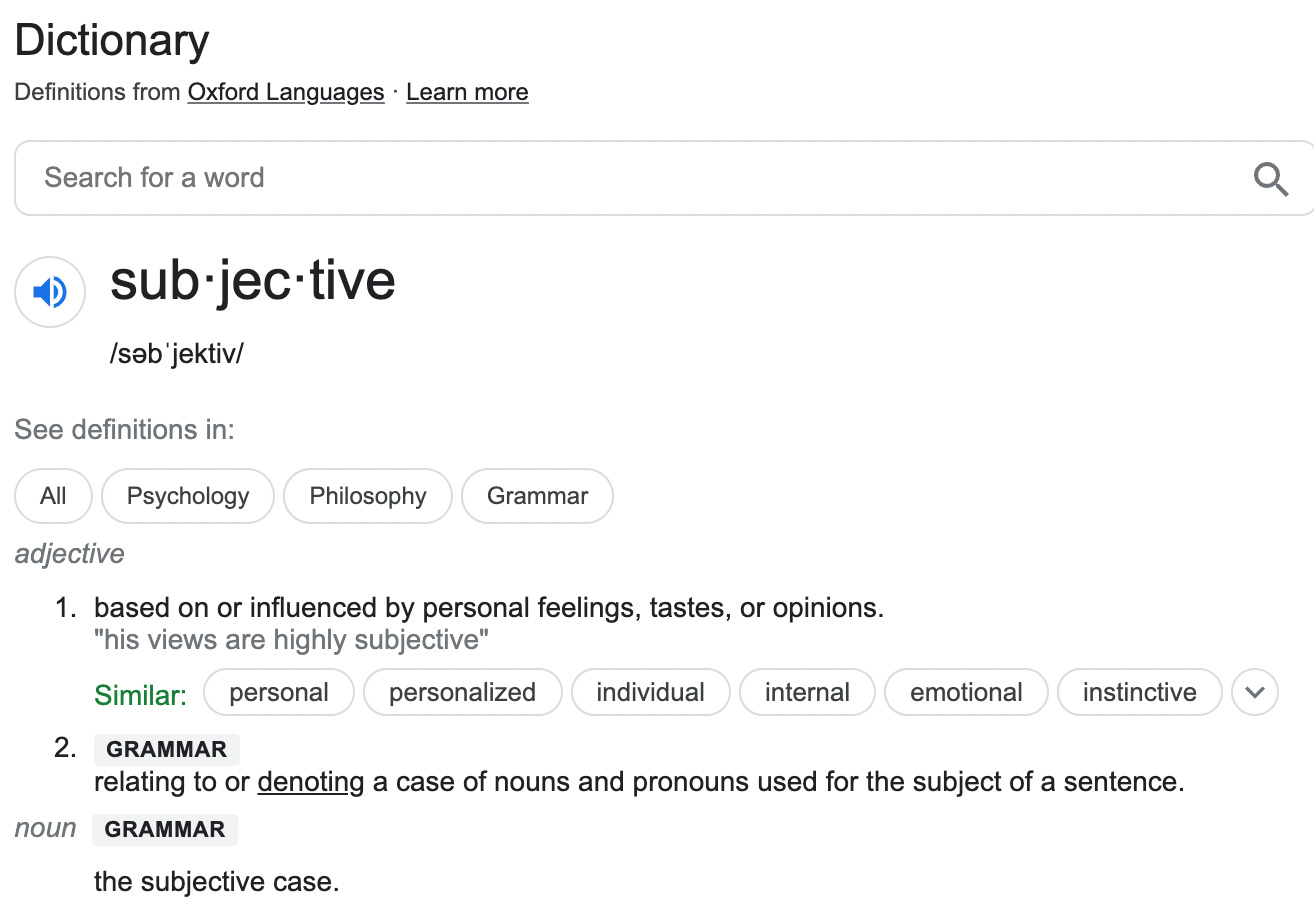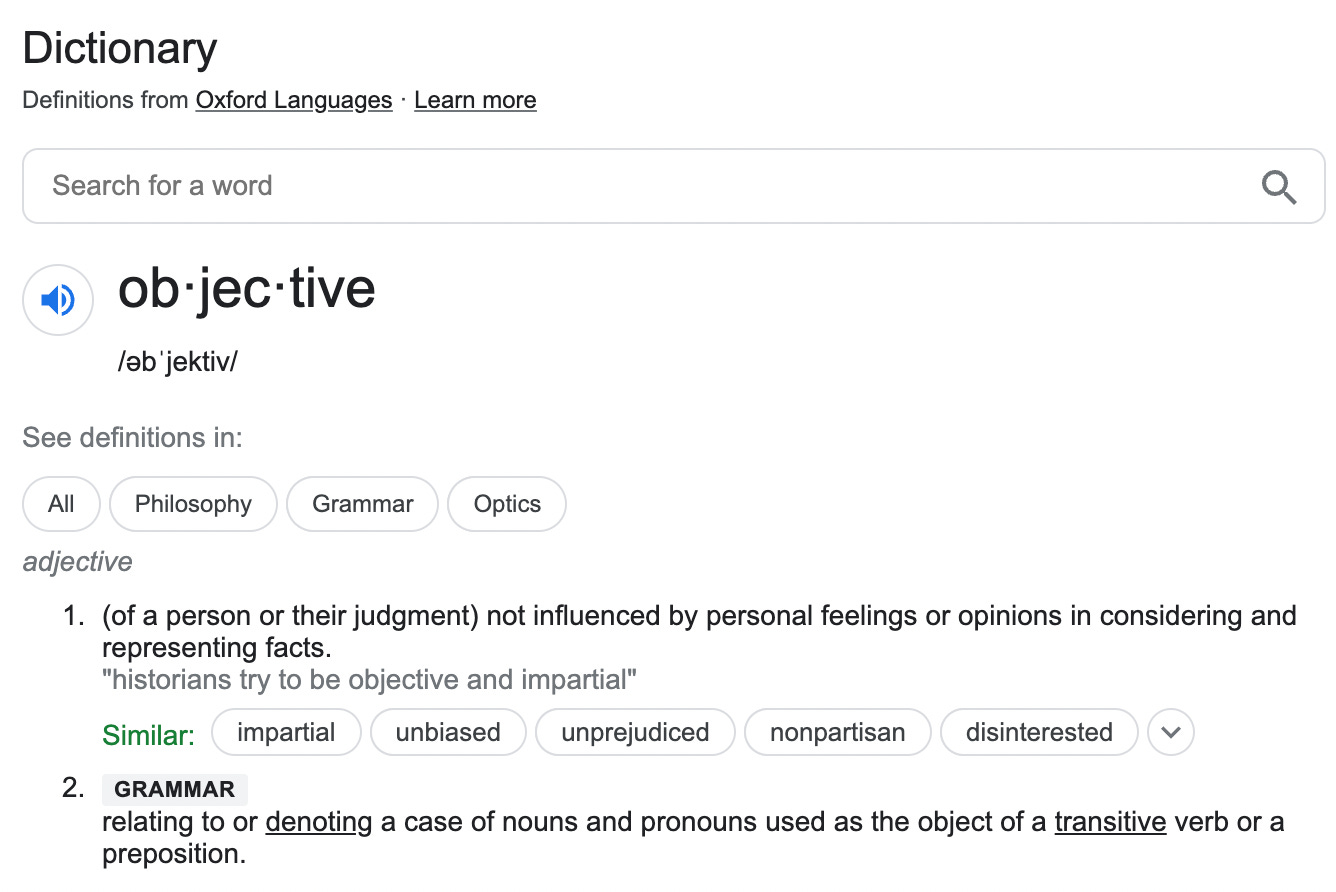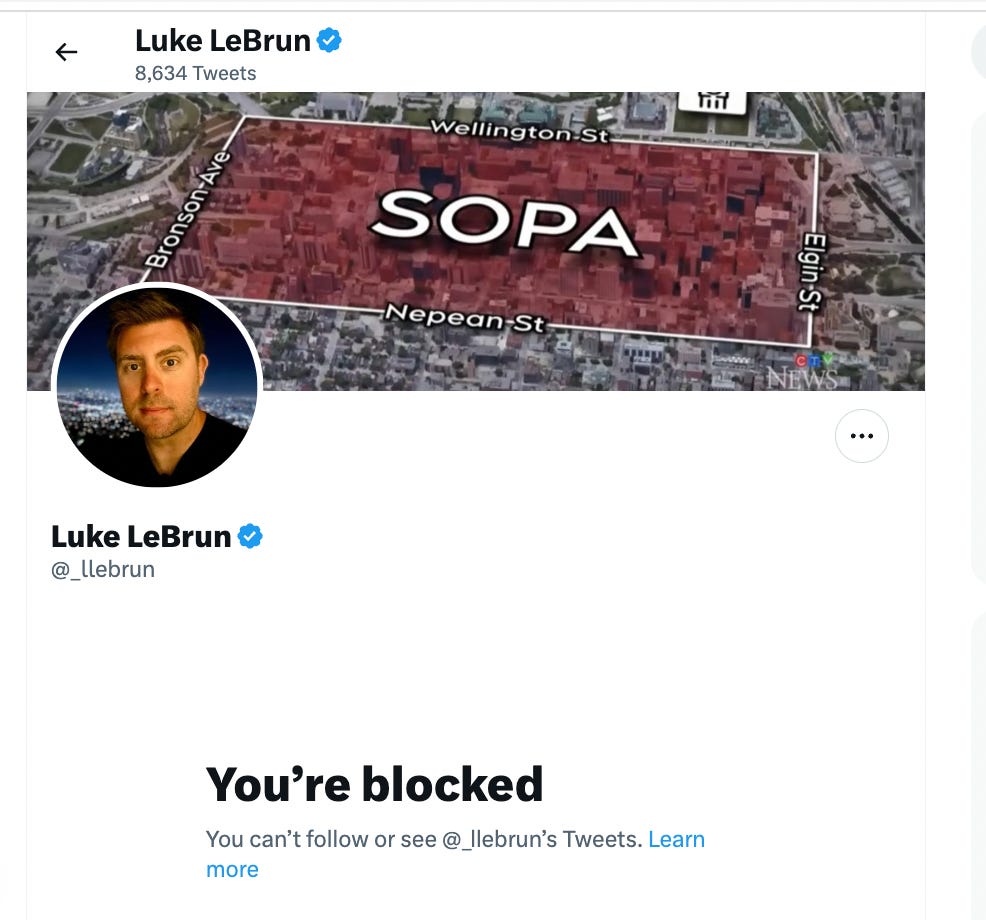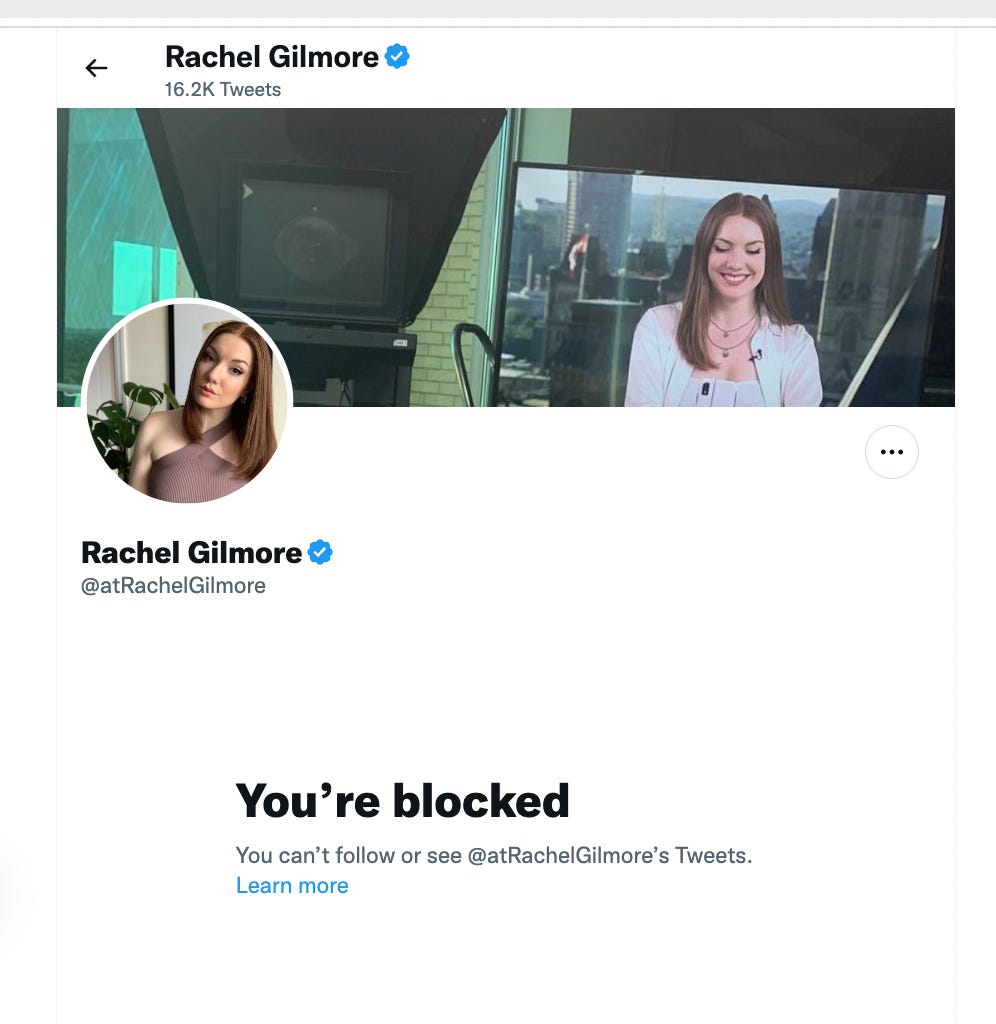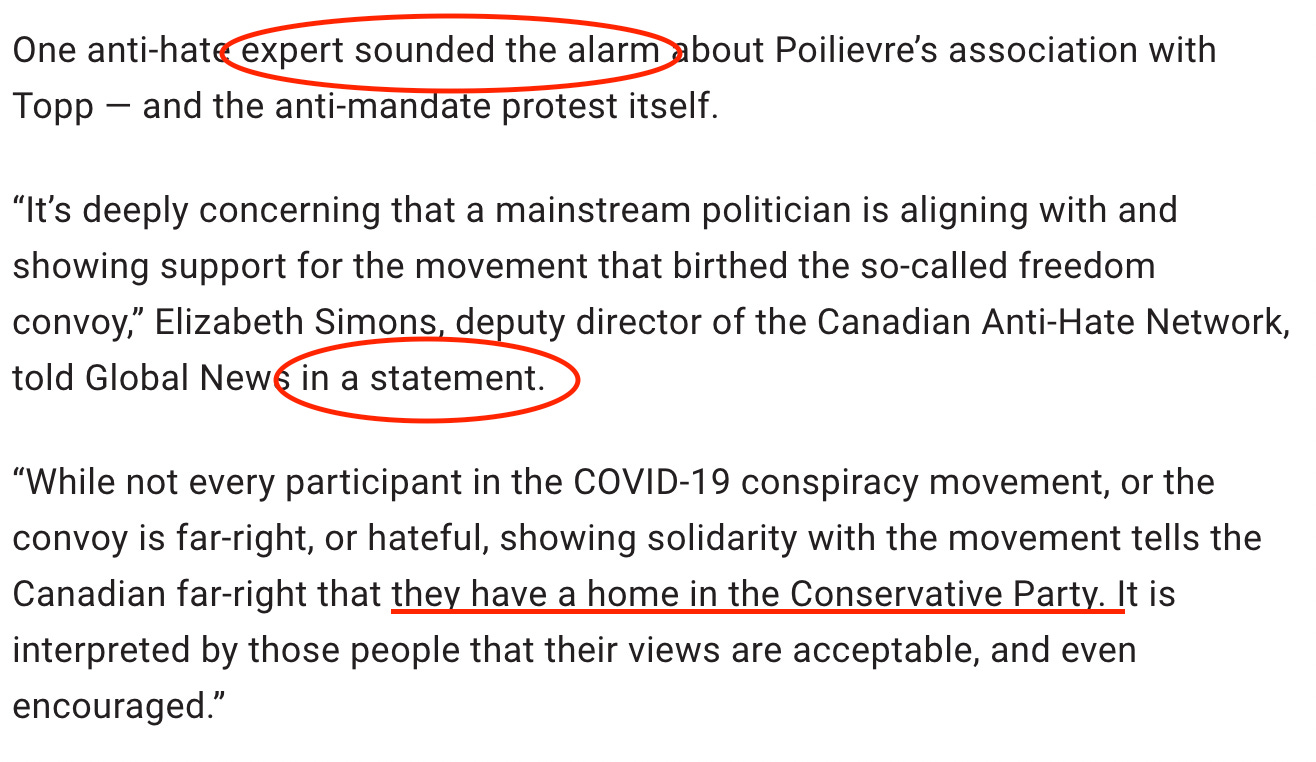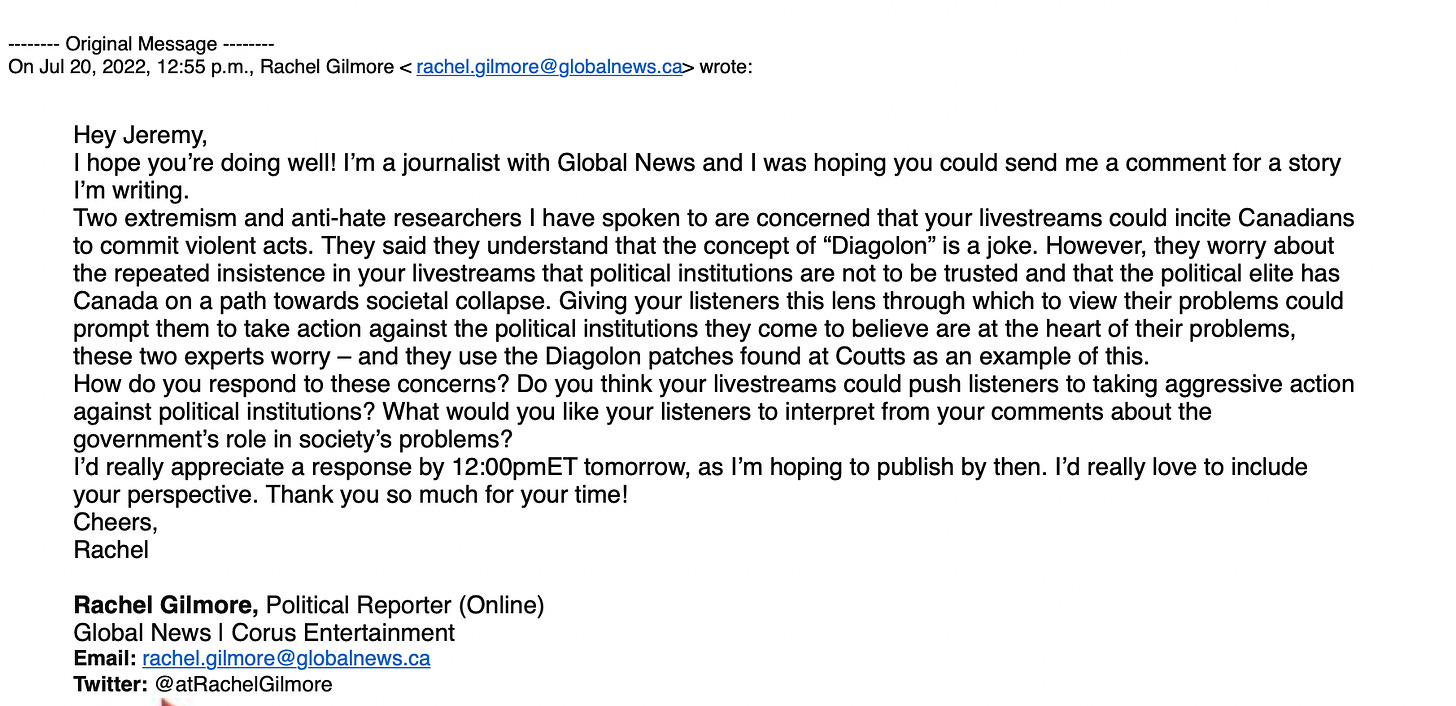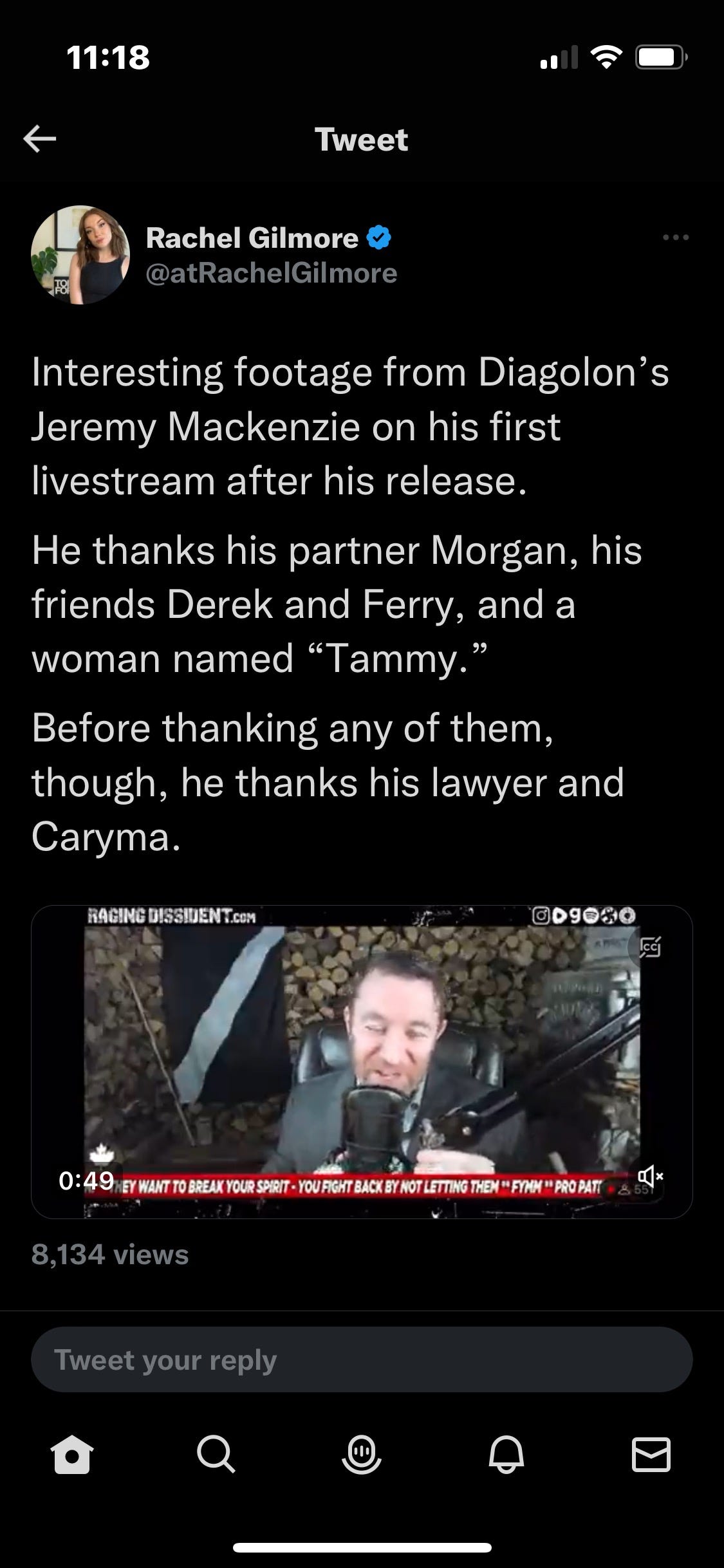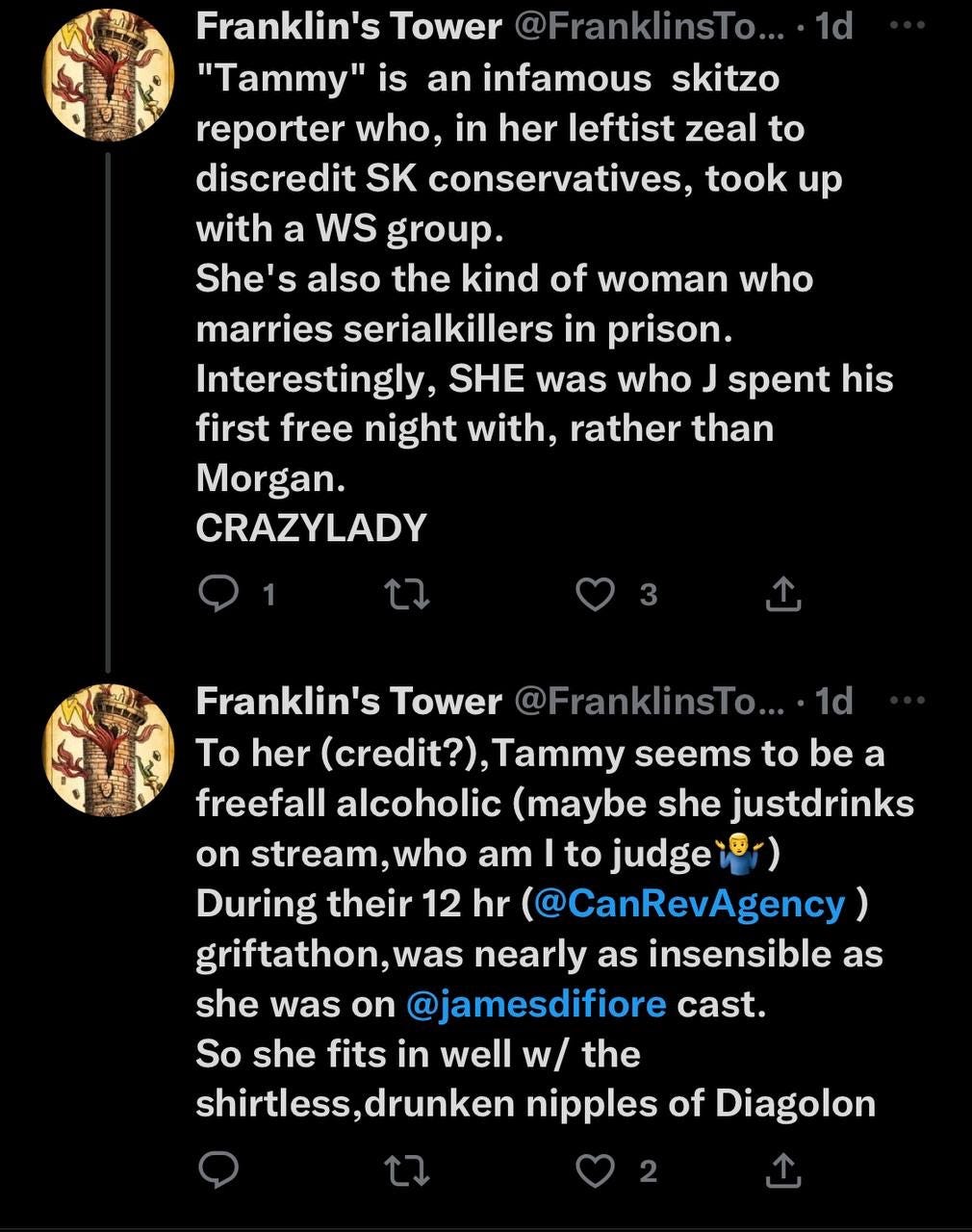Before we get started, let’s define “mainstream” (or “legacy”) media as radio, broadcast television, cable and satellite, print and billboards.
Associated with high-cost advertising and high-powered investigative political takedowns like Watergate, it’s been around for generations and was once the only way we got our news.
“Do you know the name Rachel Gilmore?”
I asked friends as I got ready to write this.
The results were fascinating. Everybody knows the Ottawa-based Global News national reporter.
As a journalist covering important Canadian issues like “federal politics, misinformation and extremism”, Gilmore should be a well-known Canadian name.
But there are plenty of good national reporters in Ottawa, so why is Rachel Gilmore famous?
Global News, her employer, is one of many media properties owned by publicly-traded Canadian telecommunications megalith Corus Entertainment, which took in $1.6-billion in revenue in 2022.
Corus’s advertising assets - revenue drivers - are broken into five categories: tv, radio, digital, services and “advanced advertising.”
Global News is the only product listed under Corus Entertainment’s “digital verticals” News products. Here’s a closer look at the stats they provide for their product:
That’s a lot of eyeballs Rachel’s reaching with her stories, which have had a real impact on real people’s real lives.
The problem with Rachel Gilmore is that Global News is positioning her as a news reporter and her work as, well, news.
It’s not.
Who “shook Pierre Poilievre’s hand”?!
The clear implication is the hand that was shaken was that of a bad Canadian, unworthy of being acknowledged by a Member of Parliament and at the time, wannabe Conservative Party of Canada leader.
You’d think a journalist would want to firmly establish the subjective premise that a private Canadian citizen is a bad person using facts, given it’s a pretty destructive one.
The journalist’s job used to be to strip as much of their own subjectivity from the equation as possible, keeping their stories objective.
Walter Cronkite set the gold standard for objectivity in journalism, signing off each of his newscasts with “That’s the way it is.”
His audience believed him.
In 2003, a few years before he died, Cronkite told Larry King in an interview,
“We all have prejudices, but we also understand how to set them aside when we do the job.”
Today, as the general public continues to hammer mainstream media out of business because they don’t trust them, some journalists want more leeway to insert bias into their work.
The Walter Cronkite School of Journalism and Mass Communication just released a report entitled Can a journalist be trustworthy without being “objective”?
The premise of the 54-page report is objectivity in journalism has never existed. It says it can’t exist because a “fact” is a three-dimensional structure that can be viewed and described differently from many angles, but only one view and angle at a time can be used to tell a story.
They’re not wrong.
It further lays out the case that until recently, those views and angles were predominantly determined by the old white males who dominated newsrooms for the first fifty years (like Walter Cronkite). Unsure what it means that the report was written by two old white males, but whatever.
Not everyone is on board with the report, which includes helpful recommendations for newsrooms like “diversity” and “define your core values”.
Phil Boas, columnist for The Arizona Republic wrote in response to the report,
“It’s simply not true that they were hard focused on white readership and the needs of white people. Most of the white journalists I’ve worked with over the years (men and women) have challenged white audiences to move beyond their racial prejudices and homophobia… Where my progressive friends and colleagues have failed has been their unwillingness to challenge minority political and cultural movements that have gone astray.”
The Washington Post issued a full-throated endorsement of the Cronkite report.
The New Yorker, IMO, nailed its response.
“It is said that objectivity is what we need more of, but that’s not what people want…In the end, we don’t care what the facts are, because there are always more facts. You can’t unspin the facts; you can only put a different spin on them. What we want is to see our enemy—Steve Bannon, Hunter Biden, whomever—in an orange jumpsuit. We want winners and losers. That is why much of our politics now takes place in a courtroom.”
Jeremy MacKenzie is one of the most political cases to hit Canadian courtrooms I’ve ever seen. Exhibit A: Gilmore’s story about Pierre Poilievre shaking his hand.
Are you not entertained?
Gilmore’s handshake story doesn’t even try. It doesn’t even mention objective facts like MacKenzie is indeed facing many criminal charges. Instead it just implies, through the story’s highly subjective and unspoken premise, that he is a bad person and we should all know so by now.
It opens with politics. Then she quotes, extensively, Elizabeth Simons, the fictional spokesperson created by the Canadian Anti-Hate Network (CAHN).
“Elizabeth Simons” is the name applied by CAHN staff, whether through written quotes or delivered via telephone interviews, when no one else at CAHN is willing to put their own to statements they’re making. This is not even a real woman using a pseudonym.
“We must explain in the story why the source requested anonymity. And, when it’s relevant, we must describe the source's motive for disclosing the information….the story also must provide attribution that establishes the source's credibility…Anything…that could reasonably be disputed should be attributed…” - AP.org
I have emailed Gilmore and as many reporters as I could find who have quoted Simons in their stories, asking them to confirm how or if they’ve met her and verified her identity or credentials.
Not one credible or meaningful response, if I got one at all.
The depth and breadth of CAHN’s Elizabeth Simons debacle, once fully known, will be international news and mainstream media outlets across Canada will pay a price for perpetuating a lie.
In late 2014 Rolling Stone published a story called “A Rape on Campus: A Brutal Assault and Struggle for Justice at UVA”. It attracted more than 2.7 million views, more than any other feature not about a celebrity in the magazine’s history.
It was also total bullshit.
Rolling Stone was rightly excoriated in a subsequent report written by the Dean of Columbia Journalism School Steve Coll and Dean of Academic Affairs Sheila Coronel on the whole sordid story of a massive journalistic fail which liberally included pseudonyms.
Coll said this when asked whether a journalist should ever use pseudonyms.
“Personally, I would start with a ban (on using pseudonyms) and take pleadings for the once-in-a-millenium exception…a question of, do you introduce fiction, affirmative fiction, because that’s what a pseudonym is… If the person’s so at risk that you believe they might be in harm’s way… well, I still wouldn’t use a pseudonym.” - Steve Coll, Dean of Columbia Journalism School
I have been attacked, threatened, slandered and blocked, including by journalists, for even asking about Simons. This includes the likes of the executive director of the publicly-funded CAHN and by the head of Press Progress, a media outlet that has used “Elizabeth Simons” repeatedly in their reporting with no caveats.
And of course,
Journalists who don’t like being questioned.
Funny how that works.
What these children journalists are broadcasting with this behaviour is that their free speech is more important than mine.
Six weeks prior to the handshake, Gilmore published her first story on MacKenzie, also rooted in the theme of guilt by association.
“…Pierre Poilievre strutted down an Ottawa street…(beside) a man in a bright vest named James Topp….can be heard chit-chatting… Topp’s recent march across Canada (protesting COVID19 vaccine mandates in the military)…Topp’s appearance on far-right figurehead Jeremy Mackenzie’s podcast for well over an hour one month ago.” - Global News, June 30, 2022
The Encyclopedia of Politics: The Left and the Right defines the “far-right” as "persons or groups who hold extreme nationalist, xenophobic, racist, religious fundamentalist, or other reactionary views."
So after neatly and subjectively labelling one Canadian resident a racist, xenophobic extremist, Gilmore tells a story about a politician walking with a different Canadian resident who once spoke to the one she’d just defined as a racist, xenophobic extremist.
Why does Gilmore believe this is news?
Well, Elizabeth Simons would love to tell you, natch.
Here’s another source for the same story.
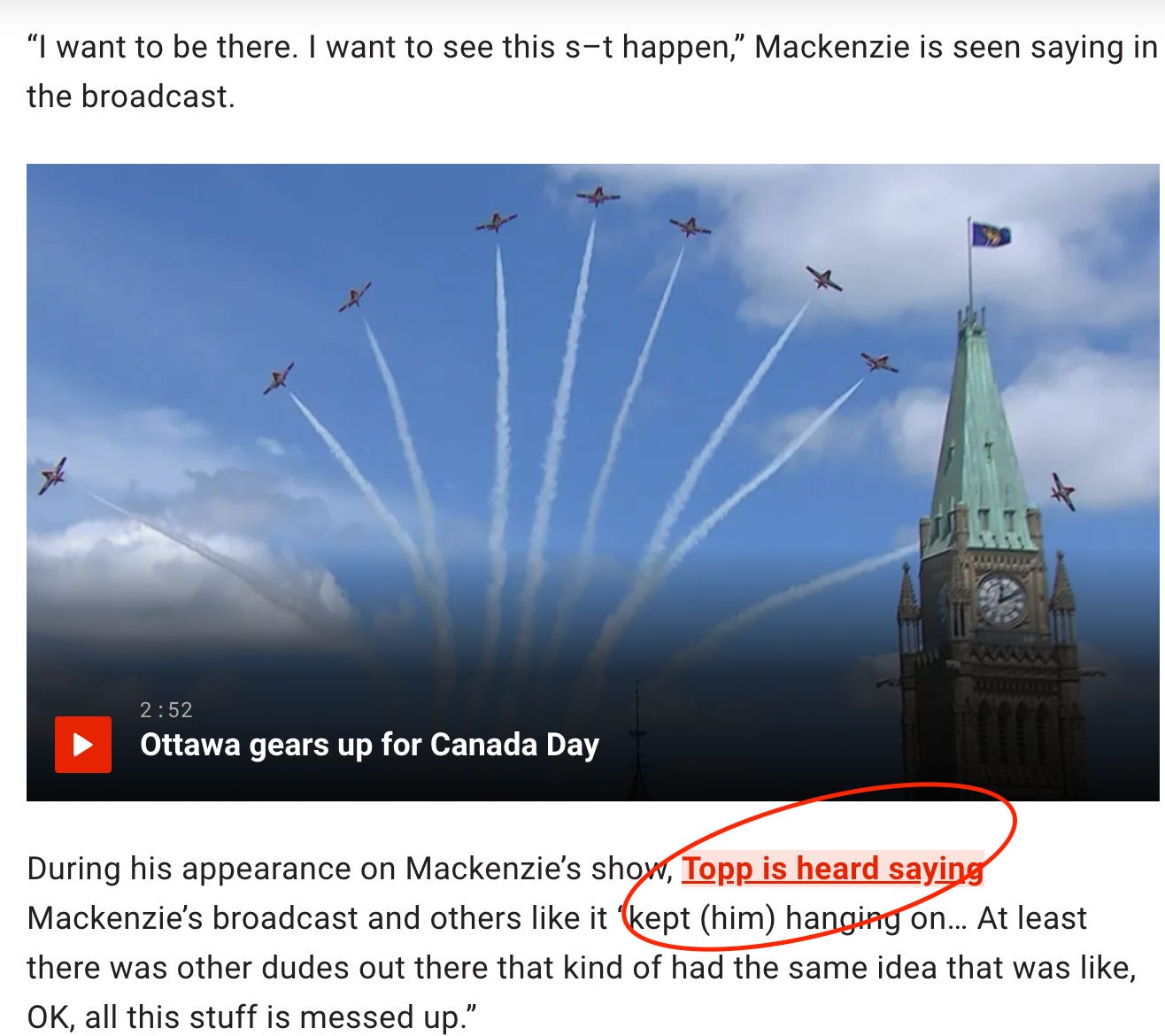
The red is a hyperlink to Tweets posted by an anonymous Twitter account with a long history of aiming libelous, destructive and other uninspired slurs about everyday Canadians, including me a “fascist” after I wrote about MacKenzie. The account is widely believed to be ran by someone closely associated with CAHN.
Gilmore claims to know the identity of that troll. She kind of has to claim that, given she’s used it as a source for a national news story. She blocked me when I asked who it was so I could sue him and was she not concerned about his credibility? Many others would like a word as well.
Yet again, Gilmore’s story doesn’t even reference Topp’s charges, just the fact Topp had spoken to Jeremy MacKenzie that one time, coupled with condemnation from a fictional character and an anonymous troll.
That’s not journalism, that’s a fairy tale.
Like me, you may not have agreed with what Topp had to say about COVID-19 and vaccines. It is our right to disagree with him and state as much, just as much as it was his to peacefully protest and express himself.
You don’t need to like what that Canadian had to say, but how dare you or anyone else shame or deny him the right to say it? Or imply he’s a bad Canadian for speaking about something you don’t want to hear?
Societal mechanisms, including the military court martial Topp is facing, exist for a reason. Those are there to hold private citizens (or in Topp’s case, members of the armed forces) accountable. Going after private citizens for publicly declaring a belief is absolutely not the media’s job.
The media’s job is to hold public figures, elected officials and actual criminals - as defined by the court of law, not public opinion - accountable.
The only media outlet that published anything on Topp suing Gilmore and Global News was the Western Standard. Burying it is a deliberate move the Canadian mainstream media made to protect their industry’s reputation.
After publishing two stories labelling MacKenzie a racist, and more Gilmore finally emailed him looking for comment, giving him til noon the following day to reply to her, at which she was going to publish a story.
Jeremy did reply.
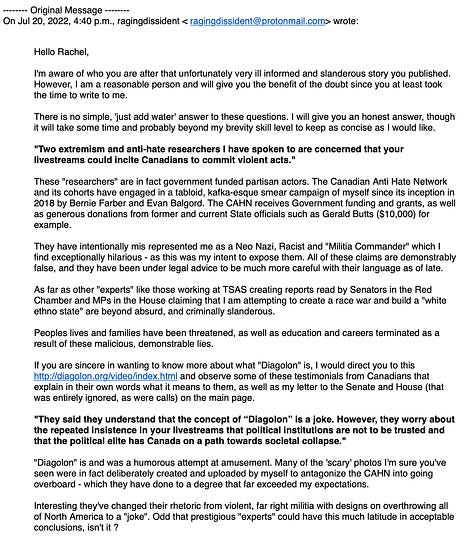
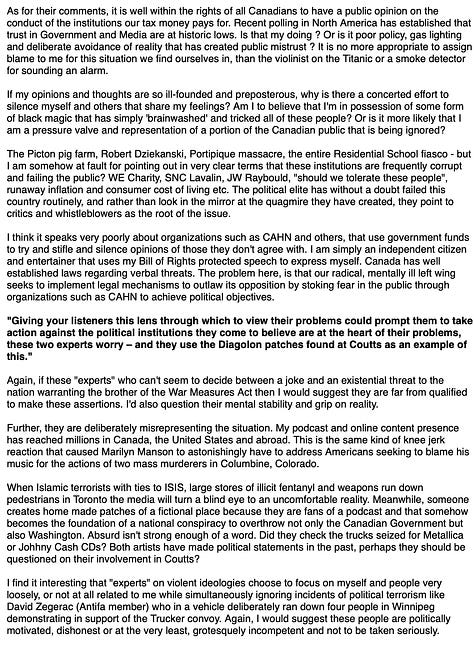
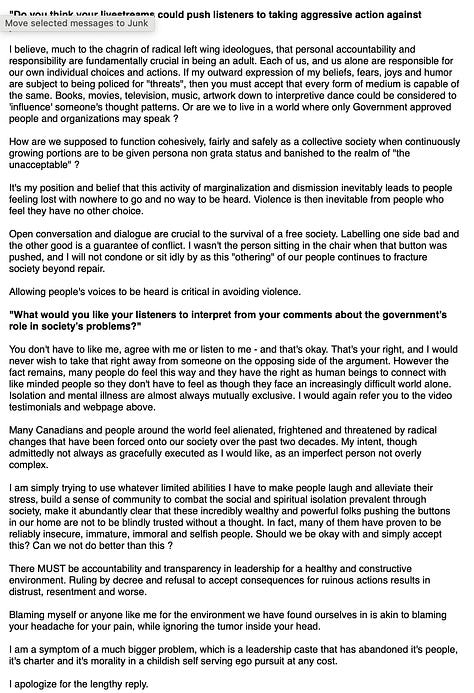
Gilmore did not publish a story the following day, nor has she used any of the copious amount of context he provided her.
She did keep Tweeting about him, however.
He and I have spoken extensively about his state of mind in August 2022. That’s a conversation I won’t be sharing, but can confirm I likely would have ended up raging too.
In early August MacKenzie did have a meltdown, saying reporters like Rachel Gilmore “deserve to be hated”, promised that “it will intensify” and that “you deserve worse and with the trajectory you’re on, you’ll get it.”
Gilmore dutifully screen-capped all of it and amplified it for her audience.
She does that alot.
If you have to tell everyone all the time that you’re a victim… well, I struggle.
Jeremy knew what he was doing when he called out Rachel Gilmore online and he shouldn’t have done it. Promoting the hate of anyone is wrong and I hope he never lowers himself to that again. I trust he won’t.
But even with his loud mouth and rabid audience, Jeremy MacKenzie’s power in and over the space in which he’s being tried and executed - the court of public opinion - is nothing compared to Rachel Gilmore’s.
Now, just because Rachel Gilmore has power does not mean she deserves to be harassed. However, power alone is also not why she’s being harassed.
To be very clear, Rachel Gilmore should not be harassed. She does not deserve harassment for anything she’s ever said or done.
None of us do.
However, because Gilmore is so generally well-known in relation to - almost an ambassador for - the important issue of women and online harassment in Canada, I think it is important to that we’re also very clear on the big picture of what her story is.
Women in Canadian journalism are threatened with torture and rape for writing stories about snow removal on city streets. In my mind, they are the true ambassadors for this issue.
In a attention-grabbing social media post in December that shunted Rachel back into the headlines, she said people are “targeting female and especially women of colour journalists, trying to silence our voices.”
That is absolutely happening… but not to Rachel Gilmore.
Instead, the backlash against Rachel is more often a result of what she and Global News have published about private citizens. The tone, language and everything else related to that backlash is often heinous and misogynistic and to be condemned… but she’s not just being harassed because she’s a woman in journalism.
Rachel Gilmore is punching down in her stories.
In July the Coalition For Women In Journalism (CFWIJ) released a wrongheaded statement supporting Gilmore after Pierre Poilievre questioned her tactics.
“…Rachel Gilmore had written two articles criticizing the conservative candidate for his support of anti vaxxer James Topp who is a veteran of the Canadian Armed Forces and has ties to several members of the far right. The journalist took to Twitter to express her frustration when Poilievre refused to answer questions and then came for her in a press release attacking her integrity while evading the questions. The Coalition For Women In Journalism condemns these tactics to silence journalists...”
I loathe Pierre Poilievre, but he was right. Gilmore exposed an overwhelming bias by identifying James Topp as a “white supremacist”, of which is there is NO evidence, in the URL attached to her story. The story itself was grossly subjective and Poilievre was correct in calling it out.
Broken clocks twice a day and all that.
The intersection of women of colour and journalism, where Rachel does not exist, is a hellspace. But it is bad journalism that erodes trust in the journalism industry and the CFWIJ chose to side with it. Shame on them, because they’re watering down the very real issues faced by women of colour in their industry.
The strength and economic viability - the power - of good journalism used to be measured in the levels of trust each outlet and reporter established with their audiences.
Influencers were teenage-girls doing makeup tutorials on Youtube.
The fundamental difference between mainstream journalists, especially those platformed nationally and private citizens using their voice through a grassroots means is mainstream journalists hold power.
After I left the newsroom, I did media relations (aka publicity or PR) for a living.
The purpose of getting a story about a client into the news cycle wasn’t just “free advertising”. I mean that’s part of it, but not all. The broader purpose was to secure the third party endorsement of the newsroom of what we were promoting.
When a story is told through a journalist’s voice, what’s being communicated alongside the subject matter is the notion that someone with authority, power, expertise and who has earned the public’s trust has deemed it information their audience needs to know.
Now go back and read what I just wrote again, but replace “newsroom” and “journalist(’s)” with “influencer(‘s)”. What’s the difference?
Spoiler alert: not enough. Not anymore. Both now bring you everything from news and entertainment to child-rearing, product reviews and health care advice.
God knows they’re bringing science. All the science.
Highly subjective, or opinion-based journalism is now being sold to the audience as news and it’s damaging both the industry and the subject matter.
If what’s left of Canadian newsrooms want to survive, it is up to journalists to work to counter this cultural phenomenon, because they have the most to lose. We do as well, but we can’t save their jobs or industry for them.
They’re only going to help themselves get their power back by raising their standards for the truth, for projecting trustworthiness and actually committing to and sticking to the facts.
As a media audience and consumer, we need to grow the fck up.
Recognize that a reporter asking a politician a question about something he or she just said is a reporter doing their job.
A journalist questioning a politician is not a journalist pledging their allegiance to the opposing party.
Acknowledge the limitations of all communication platforms, including mainstream, in keeping up with a global information tsunami.
Various folks in media, academic and political circles have gone all-in with their credibility on the theory that Jeremy MacKenzie and his livestream are an existential, dangerous threat to Canadians.
Those people have a lot at stake today, personally and professionally, because none of that has so far been proven true.
The same people who are stans of Global National’s Rachel Gilmore hate me for writing critically about the media’s coverage of Jeremy MacKenzie, including hers. Her fans have said and done the exact same things to me she claims MacKenzie’s have done to her and she stays stone cold silent.
In fact Gilmore’s own social media has prompted harassment of other women.
Putting my name in scare quotes was just so… disingenuous. She knew who I was.
It worked.
As do I, Rachel also knows the loser behind that account. She’s used him as a source; he brags about it. There is so much interplay between MacKenzie’s world and Gilmore’s that your head would spin.
To the best of my knowledge, Gilmore has never acknowledged any of the harassment or abuse levelled by her copious fans (household name, remember?) at men and women who don’t agree with her.
“I’ve got three hundred of Tammy’s Tweets about me in a folder.”
With that, John Gormley leaned back in his chair, triumphant.
It was in a meeting in December of 2021 between him, my friend and her legal counsel. He’d had asked for it after she’d Tweeted that his harassment of women, including me, from his radio show was the type of behaviour that inspired the man who gunned down 14 women in 1989 at Montreal’s École Polytechnique.
“Which one of you gets the lawsuit?” he spat, tossing a piece of scrap paper on the table.
When his efforts to expound why he had the right to slag women from his radio show failed miserably, he brought up his folder of “that time Tammy said my name” Twitter gotchas.
A grownass man, a senior citizen, whose propaganda and ideology has blanketed Saskatchewan for a mind-boggling four hours, five days a week… for over twenty-five years. Who enjoyed a personal relationship and a taxpayer-funded gig (that there’s no records for) with Grant Devine and both Sask Party premiers. Today he’s Scooter’s best boy and a regular host and guest speaker for all the Chambers of Commerce in the province as well as its controlling economic development groups.
Without a doubt one of the most well-known and powerful public figures in Saskatchewan history.
Yet, as we’ve just established, he’s not the first or only powerful mainstream media figure who has tried to shield his very public behaviour from consequences by declaring victimhood.
The notion that any content on a social media platform or blog justifies a private citizen enduring repeated assaults from a mainstream media platform is as delusional as John Gormley.
In one of her last Tweets to me, Ms Gilmore warned that I should be “very very careful” what I wrote in this piece, or some other such mildly threatening nonsense.
Frankly, she reminds me of what would have happened if someone had handed me the incredibly powerful, potentially destructive, highly-subjective, forever-archived platform she’s been given at the tender age of 28.
Thank god they did not.
Today, at 44, I have every right to weigh in on the topic of women, particularly in the public eye and realm of opinion media, enduring abuse and harassment, because it has become one of the defining stories of my career. I’m coming at this from a perspective of expertise and experience.
I know there’s plenty more that can and should be said on this issue, which is multifaceted, complex and in so many ways much bigger than Rachel Gilmore, but this is what’s realistic for one post. We will talk about Canadian media quite a bit more this year.
Talk soon,




